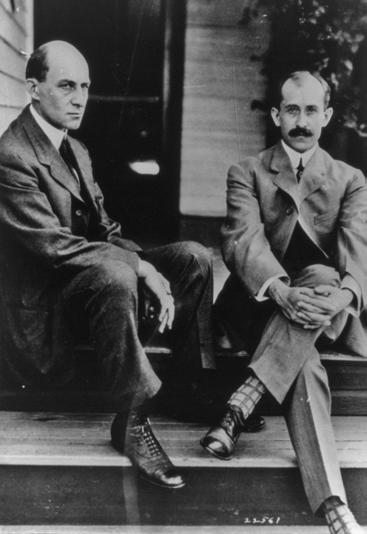
Wilbur and Orville, along with their surviving siblings (two older brothers and one younger sister), had parents who encouraged their love of science. Their mother, Susan, had studied mathematics in college. She taught her children to draw plans and to think through experiments. Their father, Milton, was a church official who traveled a great deal. He brought home presents that stimulated their interests.
Wilbur and Orville long remembered their favorite gift. It was a toy similar to today’s helicopter. It was made from cork, bamboo, and tissue paper. The brothers called it “the bat.” It was powered by two rubber bands attached to two propellers. It began their fascination with “flying machines.”
Through their teenage years, a variety of projects kept the boys’ interest. They were good at fixing and building things. Orville tried his hand at making and selling kites. He and Wilbur built a lathe together.
After working together on building a large printing press, the brothers decided to publish a weekly newspaper in the spring of 1889. Orville was the publisher, and Wilbur was the editor. In a short time, the West Side News turned into a daily newspaper with a new name, The Evening Item. Before long, though, Orville discovered another interest: bicycles.
Bicycles were popular in America in the mid-1890s. The brothers opened a series of four bicycle shops in Dayton. From them, they sold and repaired bicycles. Each shop was larger than the one that came before it. In 1896, the Wright brothers started building their own brands of bicycles—the Van Cleve and the St. Clair—with parts they manufactured themselves.
Esta historia es de la edición November/December 2023 de Cobblestone American History Magazine for Kids.
Comience su prueba gratuita de Magzter GOLD de 7 días para acceder a miles de historias premium seleccionadas y a más de 9,000 revistas y periódicos.
Ya eres suscriptor ? Conectar
Esta historia es de la edición November/December 2023 de Cobblestone American History Magazine for Kids.
Comience su prueba gratuita de Magzter GOLD de 7 días para acceder a miles de historias premium seleccionadas y a más de 9,000 revistas y periódicos.
Ya eres suscriptor? Conectar

Eye in the Sky
An interview with Joe Piotrowski

Airborne Animals
Humans have taken to the skies in balloons, gliders, and airplanes-but we're not alone among the clouds. Animals of all sorts have evolved to harness wind power.

TAKING OFF
The Wright brothers expected airplanes to “take off,” but even they might be amazed at the way the airline industry has become big business. In the past, it was expensive to send something by plane.

GROWTH OF AN INDUSTRY
After their historic flight at Kitty Hawk in 1903, Wilbur and Orville Wright returned to Dayton, Ohio. They spent the next few years making adjustments and building additional versions of their powered aircraft in their bicycle shop.

WHY KITTY HAWK?
The Wright brothers searched carefully for the best place to test their gliders and flying machines. Their main concern was for good, steady winds. But they also hoped to find a remote location to allow them to perform tests away from the public eye.

Two Brothers From Ohio
Most people do not realize that the Wright brothers—Wilbur, born in 1867, and Orville, born in 1871—performed various scientific experiments before inventing their aircraft. For as long as anyone in their hometown of Dayton, Ohio, could remember, the Wright boys had worked on mechanical projects.

A Helping Hand
May 6, 1896. A group of people who had gathered beside the Potomac River, just south of the U.S. capital, grew quiet. Then, it erupted in cheers as a small, unmanned aircraft took to the skies and flew for more than half a mile. The flight came seven years before the Wright brothers’ first manned, powered flight. The inventor of the aircraft was Dr. Samuel Pierpont Langley.

THE IDEA MEN
People dreamed of flying thousands of years before the Wright brothers found success near Kitty Hawk, North Carolina. These dreamers, such as Leonardo da Vinci, studied birds flying and imagined how humans might do the same—if only they had wings. Other men developed a more hands-on approach to the topic. Early inventors made wings of cloth, glue, and feathers and tied these creations to their arms in an attempt to imitate nature.

Da Vinci's 4 Designs
Have you ever wondered how a bird flies? Leonardo da Vinci (1452–1519) did. He thought that understanding how a bird flies would provide the key to human flight. So, what did da Vinci learn from birds?

Silken Wings
Seven hundred years before the Wright brothers began experimenting with human flight, the Chinese had already mastered its secrets—with kites.